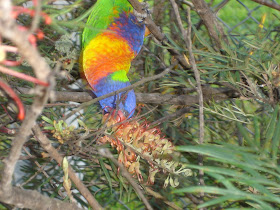

It is not unusual in Sydney to have a rainbow or two to brighten your day at this time of the year. A pair of rainbow lorikeets has been visiting in my backward every morning, since last week. It is a delight to watch them weaving,ducking and hanging upside down like acrobats through the bottlebrush trees and grevilleas srubs in my backyard. I am pleased that I did the right thing by planting native trees and scrubs, like banksias, bottlebrushes and grevilleas, in my garden to attract these bright multicoloured feathered parrots, as these native plants provide their favourite foods of nectar and pollen from their flowers.


I have stopped the practice to provide food such as store-bought nectar, sunflower seeds, and fruits such as apples, grapes and pears in a bird feeder for the birds, ever since I have learned the wrong food - grinding seeds and grain can cause damage to their beak and tongue, so it's important to let them eat food from the wild. Furthermore, feeding lorikeets and other birds, particularly processed foods such as biscuits or bread, as their digestive system does not cope with too much artificially refined sugar. In many places, including campsites and suburban gardens, wild lorikeets are so used to humans that they can be hand-fed. But beware! Dont't provide freebies to the birds. Please do not give rainbow lorikeets other kinds of food, such as biscuits, bread or seeds. They may become dependent upon these sources of food and become less inclined to forage in the wild. Eating seeds can actually cause damage to their tongue and beak. Let them feed on native plants!
I’ve lately stopped feeding the rainbow lorikeets that are coming to my place two or three times a day, after realizing that they should eat their natural food found in the wild instead of becoming dependant on processed food. After making friends with them for about a year, I get to learn a few interesting things about them. These colourful birds are paired for life just like the mandarin ducks (鸳鸯). They have dark beaks instead of red when they are young. The male and female look almost identical, and the only way I can distinguish them is by their size and the colour of the feathers on their breast. The male seems to be slightly bigger in size and has more orange feathers on its breast. If you have the rare opportunity of seeing them mating, you can be absolutely sure that the one which is in the top dominant position must be the naughty boy! Hahaha.
ReplyDeleteSampela balus kam na i stap long Garden blong mi.
ReplyDeleteHem i cam from bush kros mountain.
Tasol hem i no gat color laikim balus ples blong yu.
Mi gat memori blong you keepim kokki blong PNG.
Hi pck,
ReplyDeleteGood onya, I came across this interesting blog
http://lifes-indulgences.blogspot.com/ and the blogger writes and photographs about flora fauna found in Singapore in a beautiful way.
Cheers,
Hem gutpela balus kam long garden blong yu. Dispela kind balus hemi stap long PNG tu. Hemi likim stap long hot ples oslem nau spring ikam long Sydney na i nomore kol plenti balus bai kam bek long garden gen. Mipela na gat white pela koki olsem PNG tu tasol needim licence sapos yu keepim long pet blong yu.
ReplyDeletephil, the rainbow lorikeets are so beautiful and plentiful in australia. when we stayed at tamborine mountains, off the gold coast, they came right into our rented chalet. when we visited wilsons prom, outside melbourne, we saw a lot of them at the visitors' centre.
ReplyDeleteHi yg,
ReplyDeleteI believe the lorikeets are from the Currumbin Wildlife Sanctuary in Gold Coast :)a tourist attraction noted for its numerous lorikeets, which number in the thousands. Around 8am and 4pm each day the birds gather in a huge, noisy flock in the park's main area waiting to be fed by tourists. Do we have them in Jurong Bird Park?
phil, the last time i visited jurong bird park was decades ago. i don't know if they have lorikeets there.
ReplyDelete